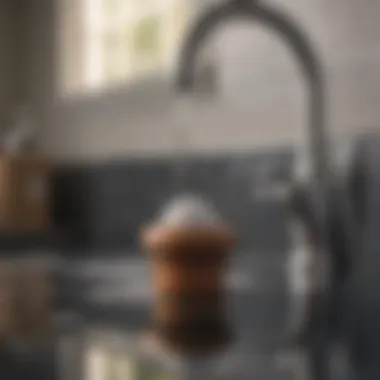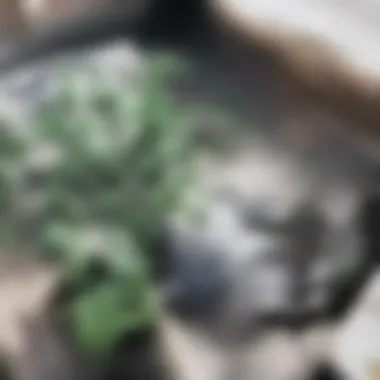Effective Methods to Unclog a Kitchen Sink with Water


Intro
Clogged sinks are a common frustration in households. When standing water fills your kitchen sink, it complicates simple tasks like washing dishes or preparing food. Knowing how to effectively address this issue is critical for maintaining a functional kitchen. Unclogging a sink requires both practical skills and an understanding of the underlying causes. In this article, various methods for resolving standing water in kitchen sinks will be detailed. Tools, step-by-step instructions, and preventative measures will also be discussed.
By familiarizing yourself with these techniques, you can transform a troublesome situation into a manageable one. The content is structured to cover both basic DIY solutions as well as more advanced plumbing options, catering to differing levels of expertise.
Understanding why clogs happen can also help in selecting the right method for removal. Factors such as food debris, grease buildup, and foreign objects are common culprits. Recognizing their impact allows for more tailored solutions, thus enhancing the effectiveness of each method.
In this guide, we will examine several approaches to unclogging a kitchen sink. Equipped with detailed guidance, readers will gain actionable insights to tackle this frequent household headache.
"An ounce of prevention is worth a pound of cure."
Understanding the Causes of Kitchen Sink Clogs
Understanding the causes of kitchen sink clogs provides crucial insights for any homeowner. Recognizing the underlying issues helps in properly addressing the problem and preventing future recurrences. By exploring what contributes to clogs, one can make informed decisions about maintenance and repair. This section focuses precisely on understanding various factors that lead to kitchen sink blockages.
Common Debris Contributing to Clogs
Many materials can accumulate in kitchen sinks over time. Common debris includes hair, soap residue, and small objects. Hair easily gets washed down the drain, especially when combined with soap. This mixture can form a dense mass, which quickly leads to clogs. Soap scum can also build up in pipelines, making it harder for water to flow. In addition, small objects like utensils or food wrappers can mistakenly fall into the sink, blocking the drain. Understanding what debris is common can inform better disposal practices during daily kitchen use.
Impact of Grease Buildup
Grease is another significant contributor to kitchen sink clogs. When cooking, excess grease from frying foods often sips into the sink. While it may seem harmless in small amounts, grease solidifies in pipes as it cools down. Over time, this buildup restricts water flow, making clogs more likely. Acknowledging the effects of grease can encourage better disposal habits. For example, scraping plates into the trash instead of rinsing them down the sink can greatly reduce grease accumulation.
Role of Food Particles
Food particles are frequently found at the heart of kitchen sink clogs. When washing dishes, bits of food may escape into the drain. Foods high in starch, like pasta or potatoes, can swell in water and form a blockage. Even smaller particles may combine with grease or soap residue, intensifying the clogging issue. Being mindful of the disposal of food waste can be beneficial. Using a garbage disposal unit can help reduce such particles in kitchen sinks.
Understanding Pipe Anatomy and Flow
A fundamental understanding of pipe anatomy and water flow is vital in addressing clogs effectively. Kitchen sink drains typically consist of several sections, including the basin, the trap, and the larger drain pipe leading to the main system. Knowing how these parts work together can help diagnose issues and determine the right method for unclogging. For instance, clogs often occur at bends or junctions, where debris tends to settle. Recognizing these points in pipe anatomy can make unclogging techniques more effective.
Initial Steps to Assess the Clog
Assessing a clog is a critical first step in the process of unclogging a kitchen sink with standing water. By taking the time to understand the situation clearly, homeowners can avoid unnecessary complications down the line. This stage entails identifying visible issues and understanding the dynamics that may be contributing to the problem.
Examining the Sink and Drain
Begin by looking closely at the sink and the drain area. Check for any obvious signs of blockage such as food particles or debris clogging the drain. If standing water is visible, this is a clear indication of a backup. It may be beneficial to physically inspect the drain opening. Use a flashlight to illuminate the drain and determine if any large debris is obstructing water flow.
Ensuring that the sink area is clean helps in easier progression to the next steps. Consider removing any accessible items under the sink for a clearer workspace and to prevent them from getting damaged.
Checking the Garbage Disposal
If your kitchen sink is equipped with a garbage disposal, it is essential to check it as part of the assessment. Start by ensuring it is switched off and disconnected from power. Look for any foreign objects that may have accidentally slipped in.
Sometimes, the blockage may originate from the disposal itself. If water is still accumulating after checking the disposal, consider running it briefly to see if this alleviates the clog. If the disposal is making unusual noises, this may signal a more significant issue that needs addressing.
Identifying the Type of Clog
Different types of clogs require different approaches. Blockages can be categorized as either partial or complete. A partial clog might allow some drainage but will typically result in slow water movement. A complete clog, however, will lead to standing water as no drains occur.
To identify the type of clog, observe the rate at which water drains when attempting to clear it. If there's a slight trickle, a partial clog exists. If the water does not drain at all, you are likely facing a complete blockage.


Basic DIY Techniques
In the context of addressing a clogged kitchen sink, Basic DIY Techniques serve as essential initial steps that can save time and money. Learning these methods can empower individuals to tackle clogs with confidence. Many people face this frustrating situation but may not know where to begin. Hence, understanding these fundamental techniques will equip readers with practical skills to handle common plumbing issues.
These techniques are typically straightforward and do not require specialized tools. Furthermore, by resolving minor clogs early, homeowners can prevent more severe plumbing issues down the line, helping to maintain their kitchen's functionality.
Using a Plunger
A plunger is a common tool found in many homes and can be a powerful ally in unclogging sinks. It works by creating pressure in the plumbing, helping to dislodge the debris causing the blockage. To use a plunger effectively, follow these steps:
- Cover the Overflow Drain: If your sink has an overflow drain, cover it with a cloth or tape to prevent air from escaping.
- Position the Plunger: Place the plunger over the sink’s drain, ensuring a good seal.
- Push and Pull: Use quick, firm movements to push down and pull up the plunger. Do this for about 15-20 seconds.
- Check the Drain: After plunging, lift the plunger and see if the water drains. If not, repeat the process.
It is important to be patient while using this method, as sometimes multiple attempts might be necessary for complete clearance. When using a plunger for kitchen sinks, an unclogging solution mixed with hot water can enhance the process, helping to dissolve buildup.
Employing a Drain Snake
A drain snake is another effective tool for clearing stubborn clogs. It consists of a long, flexible metal or plastic cable that can navigate through pipes. To use a drain snake:
- Insert the Snake: Start by inserting the end of the snake into the drain.
- Turn the Handle: As you push it further into the drain, turn the handle to navigate bends and curves.
- Feel for Resistance: When the snake meets resistance, it indicates that you have reached the clog. Continue to turn the handle to break apart the debris.
- Remove and Clean: Withdraw the snake from the drain slowly while cleaning off any accumulated debris.
This method can reach clogs that are deeper in the plumbing and might not respond to plunging. Nonetheless, care should be taken that the snake does not damage the pipes while being maneuvered.
Applying Baking Soda and Vinegar
Using baking soda and vinegar is a natural and effective way to address minor clogs. The reaction between the two creates a fizzing effect that can help break down buildup. The steps to follow are:
- Pour Baking Soda: Start by pouring about half a cup of baking soda down the drain.
- Add Vinegar: Follow it immediately with half a cup of vinegar. The bubbling reaction will help to dislodge debris.
- Cover the Drain: Place a stopper over the drain to keep the reaction contained.
- Wait and Rinse: Let this mixture sit for about 30 minutes, then flush the drain with hot water.
This method is not only effective but also environmentally friendly. It prevents the use of harsh chemicals that may harm plumbing systems or the environment.
Remember, regular maintenance is key to preventing clogs from forming. These simple DIY techniques can often solve the problem without needing to call a professional.
Advanced Unclogging Methods
Advanced unclogging methods are essential for dealing with persistent kitchen sink clogs, particularly in the presence of standing water. These methods go beyond basic DIY techniques and offer more effective solutions for severe blockages. Understanding these methods provides homeowners with greater control over plumbing issues. They also highlight the importance of thoroughness and sometimes, knowledge of plumbing systems. Efficiently tackling a stubborn clog can save time and avoid the need to call a plumber, leading to both cost and stress reduction.
Disassembling the P-Trap
The P-trap is a curved section of pipe located beneath the sink. Its design retains a small amount of water, which helps to block sewer gases from entering the home. However, this very component can be a frequent site of clogs due to debris accumulation. To disassemble the P-trap, first, place a bucket underneath to catch any water or debris that may fall. Loosen the slip nuts at either end of the trap with hand pressure or pliers, and remove it from the pipe.
Cleaning the interior part of the P-trap can be a revelation. Often, you will find hair, grease, and food particles. Dispose of this debris properly. This action not only clears the immediate blockage but also ensures that no residue remains that may cause future clogs.
In reassembling, ensure everything is tightly sealed to prevent leaks.
Here are some simple steps to follow:
- Turn off the water supply to avoid any accidents while working.
- Place a bucket beneath before removing the P-trap.
- Loosen and remove the slip nuts carefully.
- Clean the trap thoroughly before reassembling it.
Using a Wet/Dry Vacuum
A wet/dry vacuum is a powerful tool often utilized in the advanced unclogging methods arsenal. Using this equipment can efficiently extract water and debris from a clogged sink. However, it should be equipped with a proper attachment for the sink. Begin by setting the vacuum in the liquid setting, if applicable.
Insert the vacuum hose into the drain and create an airtight seal around it. This step helps to maximize suction and remove any blockages effectively. The vacuum can pull out standing water along with the debris causing the clog. After using the vacuum, it may be necessary to repeat the process a few times to ensure the drain is completely clear.
Be mindful of safety: the vacuum should not exceed its designed capacity for wet conditions. Additionally, thorough cleaning of the vacuum after use can prevent future cross-contamination from debris extracted.
Chemical Drain Cleaners: Usage and Precautions


Chemical drain cleaners can be a quick fix for stubborn clogs. They often contain corrosive substances designed to dissolve tough blockages. However, it is vital to approach these products with caution. Always read the instructions before use, as incorrect application can damage pipes, leading to more significant issues.
When using a chemical drain cleaner, follow these guidelines:
- Choose the right product based on the type of clog and your plumbing system.
- Wear protective gear such as gloves and goggles.
- Follow the manufacturer’s instructions concerning dosage and waiting time.
Always consider the environmental impact of chemical cleaners. They can be harmful to plumbing and ecosystems if not disposed of properly. In situations where clogs persist, contacting a professional may serve as a safer long-term solution.
Remember: It’s essential to understand the limitations of chemical cleaners. Overuse can lead to more complicated plumbing problems.
Preventative Measures to Avoid Future Clogs
Preventative measures play a crucial role in maintaining the functionality of your kitchen sink. Clogs can be frustrating and costly, so addressing potential issues before they escalate is wise. This section will outline effective strategies that not only contribute to the longevity of your plumbing but also ensure a smooth flow of water.
Regular Maintenance Practices
Engaging in regular maintenance is vital to prevent clogs from forming. Simple actions can make a significant difference. For example, scheduling periodic inspections of your plumbing system can catch potential issues early.
Consider the following maintenance tips:
- Flush with hot water: Once a week, run hot water down the drain. This practice helps to dissolve any minor grease or soap residues that may accumulate over time.
- Use natural cleaners: Occasionally using a mixture of baking soda and vinegar can clear minor buildups and promotes a cleaner, fresher drain.
- Check for leaks: Even small leaks can contribute to larger plumbing issues over time. Regularly inspect joints and pipes for signs of moisture.
Proper Disposal Techniques
The way you dispose of kitchen waste can significantly affect the health of your sink and pipes. Implementing appropriate disposal techniques can reduce the risk of clogs.
When using the sink, consider these guidelines:
- Avoid pouring grease: Never pour fats, oils, or grease down the drain, as they solidify and cause blockages.
- Be cautious with fibrous foods: Items like celery and potato peels do not break down easily and can lead to clogs.
- Dispose of food waste: Consider placing food scraps in compost instead of down the sink.
Educating all family members about these practices fosters a culture of responsible disposal, crucial for preventing clogs.
Using Drain Screens
Installing drain screens is an effective measure for preventing debris from entering your drainage system. They act as barriers, catching food particles and other debris before they can cause clogs.
Key benefits of drain screens include:
- Effective debris capture: They trap larger particles while allowing water to flow through unhindered.
- Ease of cleaning: Simply remove and empty them regularly to maintain optimal performance.
Incorporating drain screens into your kitchen sink setup is a small yet impactful step. It is vital to assess their condition periodically and replace them when necessary.
Implementing preventative measures can save you from the hassle and expense of frequent plumbing issues.
By being proactive and combining regular maintenance, proper disposal, and the use of drain screens, you can greatly reduce the risk of future clogs in your kitchen sink.
When to Call a Professional Plumber
Recognizing when to call a professional plumber is crucial in maintaining a properly functioning kitchen sink. Many homeowners attempt to tackle clogs independently, using various methods discussed in this article. However, certain situations warrant professional intervention. Knowing the right time to seek help can save not only time but also potential damage to your plumbing system.
Signs of a Serious Clog
Identifying the symptoms of a serious clog is the first step to deciding whether you need a plumber's aid. Here are some signs that indicate the clog may be beyond DIY solutions:
- Persistent Backups: If your sink continues to back up repeatedly, despite your best unclogging efforts, this is a clear red flag.
- Slow Draining: A slow-draining sink that doesn't improve with basic remedies might mean a more severe obstruction further down the line.
- Multiple Fixtures Affected: If you notice that the kitchen sink is not the only fixture draining poorly, for example, if toilet or shower drains also back up, there could be a blockage in the main drainage system.
- Unpleasant Odors: If foul smells linger from your sink, it might indicate decomposing food or other materials stuck in the pipes.
- Unusual Sounds: Gurgling noises emanating from the pipes can suggest air trapped due to significant blockages, signaling that professional help is needed.


"Ignoring the signs of a serious clog can lead to costly repairs down the road. It's better to act sooner rather than later."
Understanding Plumbing Codes and Regulations
It is essential to be aware of plumbing codes and regulations when dealing with serious issues. Different regions have specific plumbing standards that must be followed for safety and compliance reasons. Here’s what to consider:
- Local Laws: Plumbing work often requires knowledge of local codes. A certified plumber understands these regulations, ensuring that repairs meet legal standards.
- Safety Risks: Improper handling of plumbing issues can create hazards in your home. This can include risk of flooding, exposure to toxic substances, or structural damages.
- Insurance Factors: Many homeowner insurance policies require that plumbing work be performed by a certified professional. Attempting repairs yourself can lead to denied claims if issues arise later.
In summary, calling a professional plumber is sometimes the best course of action, especially when dealing with serious clogs or plumbing issues that may violate local codes. Assess the situation carefully, and do not hesitate to seek help when necessary.
Evaluating Long-Term Solutions
Addressing clogged kitchen sinks effectively requires not just immediate fixes, but also a deeper understanding of long-term solutions. This section focuses on sustainable methods that can help prevent future blockages, ensuring a more manageable kitchen sink experience down the line. By implementing these strategies, homeowners can save time and money, keeping their plumbing systems in optimal condition.
Upgrading Plumbing Fixtures
One significant long-term solution involves upgrading plumbing fixtures. Older fixtures may not work as efficiently as newer models.
- Flow Rate: Newer faucets and sinks often have improved flow rates, which help with faster drainage.
- Material Quality: Upgrading to higher-quality materials can reduce wear and tear over time.
- Design Features: Some modern fixtures come equipped with better strainers and built-in traps that catch debris before it becomes problematic.
Investing in fixtures with better designs can lead to fewer clog-related issues. Look for products that have been tested for durability and efficiency. Installation should ideally be done by a professional, especially if plumbing reshaping is required.
Installing a Kitchen Disposal Unit
Another effective long-term solution is the installation of a kitchen disposal unit. This device helps in grinding down food particles before they can enter the plumbing system, mitigating the risk of clogs.
- Convenience: A disposal unit allows for easy disposal of food waste, making kitchen cleanup simpler.
- Waste Reduction: It can significantly reduce the volume of waste sent to landfills, an attractive prospect for environmentally conscious homeowners.
- Maintenance: Regular maintenance of the disposal unit is required but is often simpler than dealing with clogs caused by food blockage.
Choosing a reliable brand is essential, and ensuring proper installation will maximize the unit's efficiency.
Setting Up a Routine Inspection Schedule
Lastly, setting up a routine inspection schedule can contribute significantly to maintaining an unclogged kitchen sink. Proactive measures often prevent problems from escalating.
- Regular Check-Ups: Schedule periodic inspections with a qualified plumber. These can identify potential issues before they become serious, such as signs of corrosion or weak connections.
- Educating Households: It can also be beneficial to educate all household members about proper disposal methods and maintenance practices.
- Documentation: Keeping records of past inspections will provide insight into recurring issues, enabling more targeted solutions.
Incorporating a detailed routine can be an instrumental strategy in simplifying life at home.
Long-term solutions not only address current problems but also set a foundation for more reliable kitchen plumbing.
In summary, evaluating long-term solutions involves careful consideration of various upgrades and practices that promote a smooth-running kitchen. By focusing on plumbing fixture upgrades, disposal unit installation, and routine inspections, substantial progress can be made in preventing kitchen sink clogs.
The End and Key Takeaways
In addressing the issue of a clogged kitchen sink, it is crucial to synthesize the overarching methods and insights presented throughout this article. Effectively managing a sink with standing water requires a combination of timely assessment, strategic approaches, and ongoing preventative strategies. By understanding the characteristics of common clogs and recognizing when to apply specific techniques, one can significantly reduce the frequency and severity of plumbing issues.
Summary of Methods Discussed
The article delineates various methods for unclogging a kitchen sink. Each technique has its unique attributes and best-use scenarios:
- Basic DIY Techniques: This includes straightforward actions such as using a plunger, employing a drain snake, and utilizing a baking soda and vinegar concoction. These are often the first steps to take.
- Advanced Unclogging Methods: If basic techniques fall short, more complex methods like disassembling the P-trap or utilizing a wet/dry vacuum can provide effective resolutions. Chemical drain cleaners are also an option, provided one follows safety precautions.
- Preventative Measures: Regular maintenance through proper disposal techniques and the use of drain screens plays a significant role in avoiding future clogs.
A balanced approach is encouraged, mixing immediate responses with long-term strategies for maintenance.
Final Advice on Maintenance
Maintenance is key to a smoothly functioning kitchen sink. Regular checks on the plumbing system and being mindful of what goes down the drain can save time, effort, and potential expenses in the long run. Implementing routine inspections can help catch small issues before they become significant problems.
Furthermore, ensure that proper disposal techniques are followed. Items like grease and coffee grounds should never be poured down the sink. Using drain screens can act as a barrier against larger debris, protecting your plumbing system. This proactive strategy not only enhances the performance of your kitchen sink but also prolongs the lifespan of the plumbing.
In summary, the combination of understanding, immediate methods, and proactive maintenance not only unclogs a sink effectively but also establishes a lasting solution to prevent reoccurring issues. Achieving this balance will considerably improve kitchen functionality.















